Regime Shifts in the Hexi Oases over the Past Three Decades: The Case of the Linze Oasis in the Middle Reaches of the Heihe River
Abstract
1. Introduction
2. Material and Methods
2.1. Study Region
2.2. Data and Data Processing
2.3. Methods
2.3.1. Water Consumption of Crop Farming
2.3.2. Analysis of Crop Farming Restructuring
2.3.3. Effects of Crop Farming Restructuring on Water Savings
2.3.4. Effects of Crop Farming Restructuring on Water Productivity
3. Results
3.1. Regimes at the Oases Scale
3.2. Regimes in the Structures of the Oases
3.2.1. Structural Diversity of Crops
3.2.2. Changes in Water Savings
3.2.3. Changes in Water Productivity
4. Discussion
4.1. Regime Shifts in Oases and their Dominant Drivers
4.2. Effects of Policies and Economic Factors on Oases Regimes
5. Conclusions
Supplementary Materials
Author Contributions
Funding
Institutional Review Board Statement
Informed Consent Statement
Data Availability Statement
Conflicts of Interest
References
- Biggs, R.; Carpenter, S.R.; Brock, W.A. Turning back from the brink: Detecting an impending regime shift in time to avert it. Proc. Natl. Acad. Sci. USA 2009, 106, 826–831. [Google Scholar] [CrossRef] [PubMed]
- Rocha, J.; Peterson, G.; Bodin, Ö.; Simon, L. Cascading regime shifts within and across scales. Science 2018, 362, 1379–1383. [Google Scholar] [CrossRef] [PubMed]
- Xie, Y.; Bie, Q.; Lu, H.; He, L. Spatio-temporal changes of oases in the Hexi Corridor over the past 30 years. Sustainability 2018, 10, 4489. [Google Scholar] [CrossRef]
- Meng, J.; Wu, X.; Li, Z. Landuse/landcover changes in Zhangye oasis of Hexi Corridor. J. Geogr. Sci. 2003, 13, 71–75. [Google Scholar] [CrossRef]
- Luo, L.; Zhuang, Y.; Zhao, W.; Duan, Q.; Wang, L. The hidden costs of desert development. Ambio 2020, 49, 1654–7209. [Google Scholar] [CrossRef] [PubMed]
- Song, W.; Zhang, Y. Expansion of agricultural oasis in the Heihe River basin of China: Patterns, reasons and policy implications. Phys. Chem. Earth Parts A/B/C 2015, 89, 46–55. [Google Scholar] [CrossRef]
- Peng, Y.; Zhang, Q.; Chen, Y.; Xu, N.; Qiao, Y.; Tian, C.; Hirwa, H.; Diop, S.; Guisse, A.; Li, F. Resilience, adaptability, and regime shifts thinking: A perspective of dryland socio-ecology system. J. Resour. Ecol. 2021, 12, 376–383. [Google Scholar]
- Lade, S.J.; Tavoni, A.; Levin, S.A.; Schlüter, M. Regime shifts in a social-ecological system. Theor. Ecol. 2013, 6, 359–372. [Google Scholar] [CrossRef]
- Zhou, D.; Wang, X.; Shi, M. Human driving forces of oasis expansion in Northwestern China during the last decade—A case study of the Heihe River Basin. Land Degrad. Dev. 2017, 28, 412–420. [Google Scholar] [CrossRef]
- Reyers, B.; Folke, C.; Moore, M.L.; Biggs, R.; Galaz, V. Social-ecological systems insights for navigating the dynamics of the anthropocene. Annu. Rev. Environ. Resour. 2018, 43, 267–289. [Google Scholar] [CrossRef]
- Zhang, J.; Ji, X.; Chen, X.; Xu, S.; Jiao, D. Regional supply-demand balance and carrying capacity of water resources for Linze Oasis in the middle of Hexi Corridor. Arid Land Geogr. 2018, 41, 38–47. (In Chinese) [Google Scholar] [CrossRef]
- Sivapalan, M.; Savenije, H.H.; Blöschl, G. Socio-hydrology: A new science of people and water. Hydrol. Process 2012, 26, 1270–1276. [Google Scholar] [CrossRef]
- Cheng, G.; Li, X.; Zhao, W.; Xu, Z.; Feng, Q.; Xiao, S.; Xiao, H. Integrated study of the water–ecosystem–economy in the Heihe River Basin. Natl. Sci. Rev. 2014, 1, 413–428. [Google Scholar] [CrossRef]
- Xiao, S.; Xiao, H.; Mi, L.; Li, L.; Lu, Z.; Peng, X. Scientific assessment on ecological effects of national integrated management project in Heihe River Basin. Bull. Chin. Acad. Sci. 2017, 32, 45–54. (In Chinese) [Google Scholar]
- Wang, C.; Zhao, W.; Zhang, Y. Runoff controls the development of eco-hydrological and economic conditions in an arid oasis of the downstream inland river basin. Arid Land Res. Manag. 2022, 36, 265–282. [Google Scholar] [CrossRef]
- Geng, W.; Jiang, X.; Lei, Y.; Zhang, J.; Zhao, H. The allocation of water resources in the midstream of Heihe River for the “97 water diversion scheme” and the “three red lines”. Int. J. Environ. Res. Public Health 2021, 18, 1887. [Google Scholar] [CrossRef]
- Kang, E.; Chen, R.; Zhang, Z.; Ji, X.; Jin, B. Some scientific problems facing research on hydrological processes in an Inland River Basin. Front. Earth Sci. China 2008, 2, 384–392. [Google Scholar] [CrossRef]
- Lu, Z.; Feng, Q.; Xiao, S.; Xie, J.; Zou, S.; Yang, Q.; Si, J. The impacts of the ecological water diversion project on the ecology-hydrology-economy nexus in the lower reaches in an inland river basin. Resour. Conserv. Recycl. 2021, 164, 105154. [Google Scholar] [CrossRef]
- Shi, M.; Wang, L.; Wang, X. A study on changes and driving factors of agricultural water supply and demand in Zhangye after water reallocation of the Heihe River. Resour. Sci. 2011, 33, 1489–1497. (In Chinese) [Google Scholar]
- Zhao, W.; Ji, X. Spatio-temporal variation in transpiration responses of maize plants to vapor pressure deficit under an arid climatic condition. J. Arid Land 2016, 8, 409–421. [Google Scholar] [CrossRef]
- Li, Y.; Huang, C.; Hou, J.; Gu, J.; Zhu, G.; Li, X. Mapping daily evapotranspiration based on spatiotemporal fusion of ASTER and MODIS images over irrigated agricultural areas in the Heihe River Basin, Northwest China. Agric. For. Meteorol. 2017, 244, 82–97. [Google Scholar] [CrossRef]
- He, Z.; Zhao, W.; Fang, J. Ecological water requirement of oasis shelter-forest system in northwest China. Geosci. Remote Sens. Symp. 2005, 6, 4411–4414. [Google Scholar]
- Deng, X.; Lun, S.; Zhang, H.; Turner, N. Improving agricultural water use efficiency in arid and semiarid areas of China. Agric. Water Manag. 2006, 80, 23–40. [Google Scholar] [CrossRef]
- Madani, K.; Shafiee-Jood, M. Socio-hydrology: A new understanding to unite or a new science to divide? Water 2020, 12, 1941. [Google Scholar] [CrossRef]
- Liu, X.; Shen, Y. Water requirements of the oasis in the middle Heihe River Basin China: Trends and causes. Earth Syst. Dyn. Discuss 2017. [Google Scholar] [CrossRef]
- Cheng, G.; Xiao, H.; Fu, B. Advances in synthetic research on the eco-hydrological process of the Heihe River basin. Adv. Earth Sci. 2014, 29, 431–437. (In Chinese) [Google Scholar]
- Wanniarachchi, S.; Sarukkalige, R. A review on evapotranspiration estimation in agricultural water management: Past, present, and future. Hydrology 2022, 9, 123. [Google Scholar] [CrossRef]
- Wang, H.; Yang, G.; Jia, Y.; Qin, D.; Gan, H.; Wang, J.; Han, C. Necessity and feasibility for an ET-based modern water resources management strategy: A case study of soil water resources in the Yellow River Basin. Sci. China Ser. E-Tech. Sci. 2009, 52, 3004–3016. (In Chinese) [Google Scholar] [CrossRef]
- Sun, D.; Li, Y.; Hu, X.; Wang, J.; Lu, S.; Cheng, Y. Study on balance and configuration of water resources supply and demand in Heihe River basin. Res. Soil Water Conserv. 2014, 21, 217–221. (In Chinese) [Google Scholar]
- Lian, J.; Huang, M. Evapotranspiration estimation for an oasis area in the Heihe River Basin using Landsat-8 images and the METRIC model. Water Resour. Manag. 2015, 29, 5157–5170. [Google Scholar] [CrossRef]
- Liu, Y.; Wang, J. Revealing annual crop type distribution and spatiotemporal changes in northeast China based on google earth engine. Remote Sens. 2022, 14, 4056. [Google Scholar] [CrossRef]
- Cheng, G. Water-Ecology-Economy Management in the Heihe River Basin; Science Press: Beijing, China, 2009; pp. 227–319. [Google Scholar]
- Witkowski, K. The development of the use of water energy in the mountain catchment from a socio-hydrological perspective. Energies 2022, 15, 7770. [Google Scholar] [CrossRef]
- Ji, X.; Zhao, W.; Kang, E.; Jin, B.; Xu, S. Transpiration from Three Dominant Shrub Species in a Desert-oasis Ecotone of Arid Regions of Northwestern China: Transpiration from Shrubs of Oasis-desert Ecotone. Hydrol. Process. 2016, 30, 4841–4854. [Google Scholar] [CrossRef]
- Jiao, D.; Ji, X.; Liu, J.; Zhao, L.; Jin, B.; Zhang, J.; Guo, F. Quantifying spatio-temporal variations of evapotranspiration over a heterogeneous terrain in the Arid regions of Northwestern China. Int. J. Remote Sens. 2021, 42, 3231–3254. [Google Scholar] [CrossRef]
- Zhao, L.; Zhao, W.; Ji, X. Division between transpiration and evaporation, and crop water consumption over farmland within oases of the middle stream of Heihe River basin, Northwestern China. Acta Ecol. Sin. 2015, 35, 1114–1123. (In Chinese) [Google Scholar]
- Ji, X.; Kang, E.; Zhao, W.; Chen, R.; Xiao, S.; Jin, B. Analysis on supply and demand of water resources and evaluation of the security of water resources in irrigation region of the middle reaches of Heihe River, Northwest China. Sci. Agric. Sin. 2005, 38, 974–982. (In Chinese) [Google Scholar]
- Filatova, T.; Polhill, J.; Van Ewijk, S. Regime shifts in coupled socio-environmental systems: Review of modelling challenges and approaches. Environ. Model. Softw. 2016, 75, 333–347. [Google Scholar] [CrossRef]
- Andersen, T.; Carstensen, J.; Hernandez-Garcia, E.; Duarte, C.M. Ecological thresholds and regime shifts: Approaches to identification. Trends Ecol. Evol. 2009, 24, 49–57. [Google Scholar] [CrossRef]
- Ulanowicz, R.E. Growth and Development: Ecosystems Phenomenology; Springer Science & Business Media: Berlin/Heidelberg, Germany, 2012. [Google Scholar]
- Tilman, D.; Wedin, D.; Knops, J. Productivity and sustainability influenced by biodiversity in grassland ecosystems. Nature 1996, 379, 718–720. [Google Scholar] [CrossRef]
- Xu, Z.; Cheng, G.; Chen, D.; Templet, P.H. Economic diversity, development capacity and sustainable development of China. Ecol. Econ. 2002, 40, 369–378. [Google Scholar] [CrossRef]
- Zhou, J.; Shi, P.; Li, L. Study on the planting industry structure adjustment and its impact on the water demand of crops in Minqin oasis. J. Nat. Resour. 2016, 31, 822–832. (In Chinese) [Google Scholar]
- Liu, J.; Wu, P.; Wang, Y.; Zhao, X.; Sun, S.; Chao, X. Impacts of changing cropping pattern on virtual water flows related to crops transfer: A case study for the Hetao irrigation district, China. J. Sci. Food Agric. 2014, 94, 2992–3000. [Google Scholar] [CrossRef] [PubMed]
- Lei, B.; Liu, Y.; Xu, D.; Jiang, W. Advances in evaluation study on utility of agriculture water utilization. Adv. Water Sci. 2009, 20, 732–738. (In Chinese) [Google Scholar]
- Molden, D.; Oweis, T.; Steduto, P.; Bindraban, P.; Hanjra, M.; Kijne, J. Improving agricultural water productivity: Between optimism and caution. Agric. Water Manag. 2010, 97, 528–535. [Google Scholar] [CrossRef]
- Seckler, D.; Molden, D.; Sakthivadivel, R. The concept of efficiency in water resources management and policy. Water Product. Agric. Limits Oppor. Improv. 2003, 1, 37–51. [Google Scholar]
- Molden, D.; Murray-Rust, H.; Sakthivadivel, R.; Makin, W. (Eds.) Water Productivity in Agriculture: Limits and Opportunities for Improvement; CAB International, Publishing and International Water Management Institute: Wallingford, UK; Colombo, Sri Lanka, 2003. [Google Scholar]
- Deng, X.; Zhao, C. Identification of water scarcity and providing solutions for adapting to climate changes in the Heihe River Basin of China. Adv. Meteorol. 2015, 2015, 279173. [Google Scholar] [CrossRef]
- Wang, G.; Chen, J.; Wu, F.; Li, Z. An integrated analysis of agricultural water-use efficiency: A case study in the Heihe River Basin in Northwest China. Phys. Chem. Earth Parts A/B/C 2015, 89, 3–9. [Google Scholar] [CrossRef]
- Li, X.; Han, Z.B.; Zhang, B.Q.; Gao, C.; He, C.S. Optimization of crop irrigation scheduling in the middle reaches of the Heihe River Basin. Acta Ecol. Sin. 2021, 41, 3067–3077. [Google Scholar]
- Cui, Y.; Xiong, J. Advances in assessment indicators of irrigation water use efficiency. Adv. Water Sci. 2009, 20, 590–598. (In Chinese) [Google Scholar]
- Frederiks, E.; Stenner, K.; Hobman, E. Household energy use: Applying behavioural economics to understand consumer decision-making and behavior. Renew. Sustain. Energy Rev. 2015, 41, 1385–1394. [Google Scholar] [CrossRef]
- Li, G.; Shi, M.; Zhou, D. How much will farmers be compensated for water reallocation from agricultural water to the local ecological sector on the edge of an oasis in the Heihe River Basin. Agric. Water Manag. 2021, 249, 106801. [Google Scholar] [CrossRef]
- Zhu, Y.; Chen, Y.; Ren, L.; Zhao, W.; Yuan, F.; Xu, M. Ecosystem restoration and conservation in the arid inland river basins of Northwest China: Problems and strategies. Ecol. Eng. 2016, 94, 629–637. [Google Scholar] [CrossRef]
- Li, D.; Wang, X. Assessing irrigated water utilization to optimize irrigation schedule in the oasis-desert ecotone of Hexi Corridor of China. Agric. Ecosyst. Environ. 2021, 322, 107647. [Google Scholar] [CrossRef]
- Zhang, J.; Kang, E.; Lan, Y. Studies of the transformation between surface water and groundwater and the utilization ratio of water resources in Hexi region. J. Glaciol. Geocryol. 2001, 23, 375–382. [Google Scholar]
- Dadson, S.; Acreman, M.; Harding, R. Water security, global change and land–atmosphere feedbacks. Phil. Trans. R. Soc. A 2013, 371, 20120412. [Google Scholar] [CrossRef] [PubMed]
- Wu, F.; Zhang, Q.; Gao, X. Does water-saving technology reduce water use in economic systems? A rebound effect in Zhangye city in the Heihe River Basin, China. Water Policy 2017, 20, wp2017003. [Google Scholar] [CrossRef]
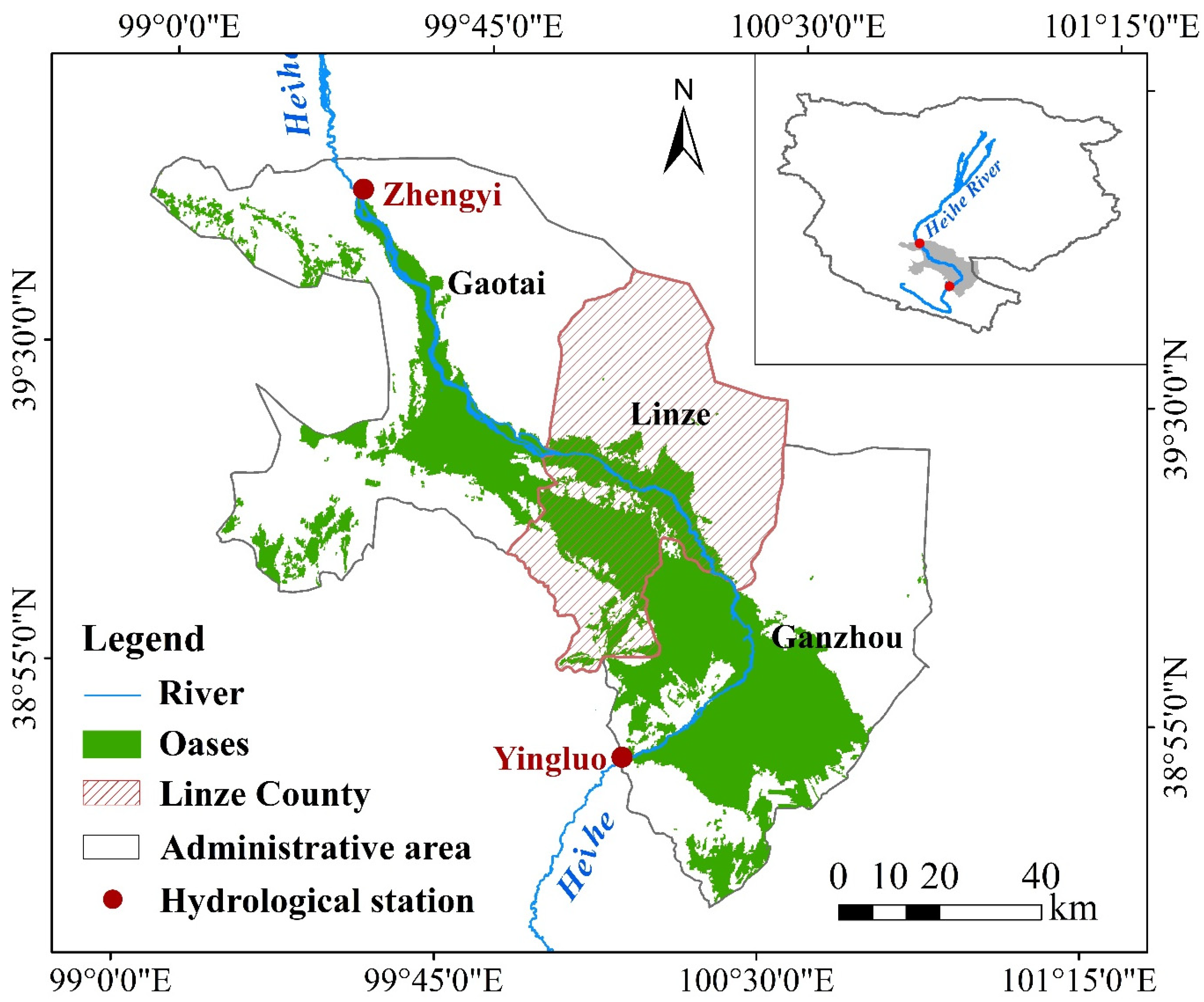
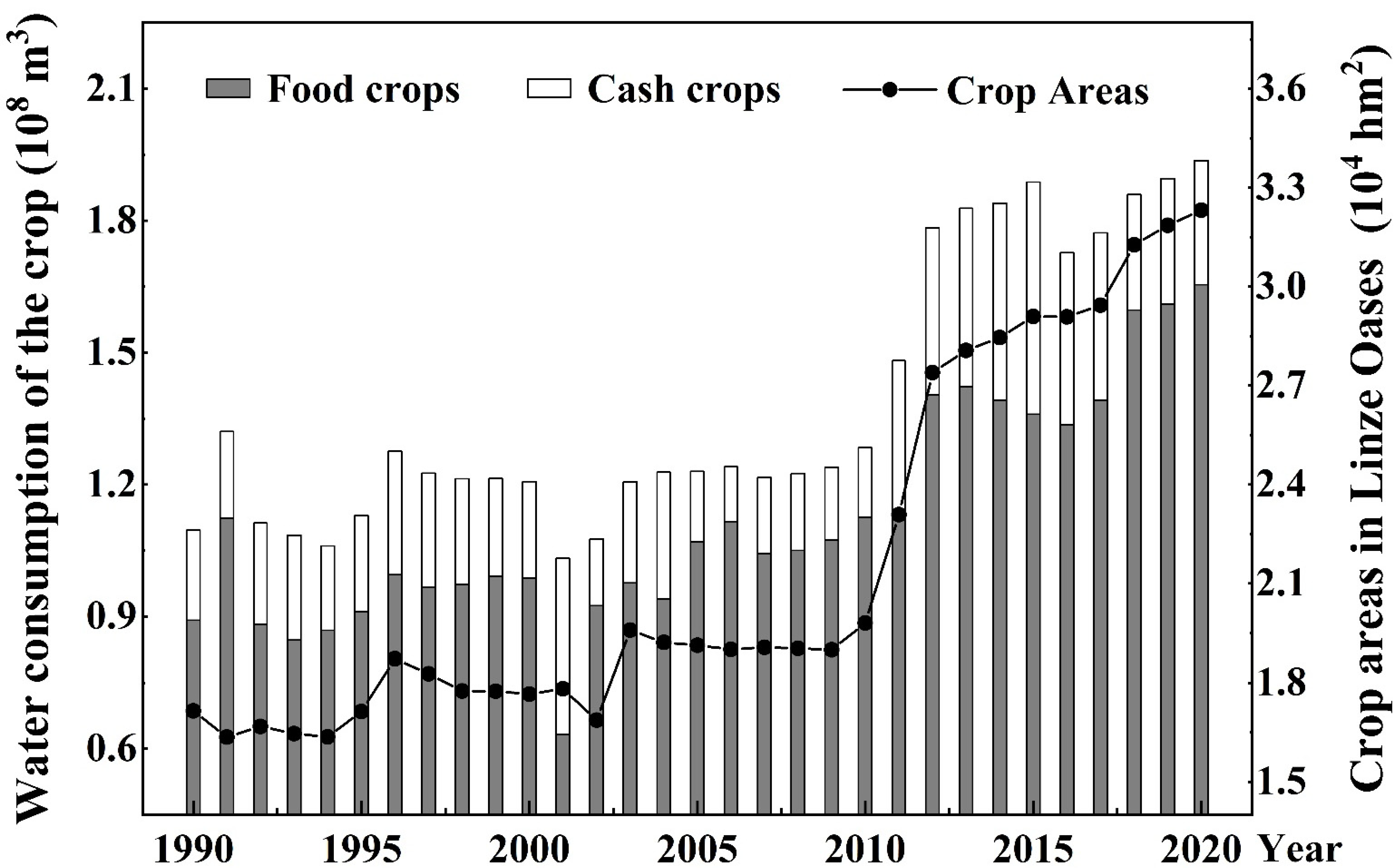

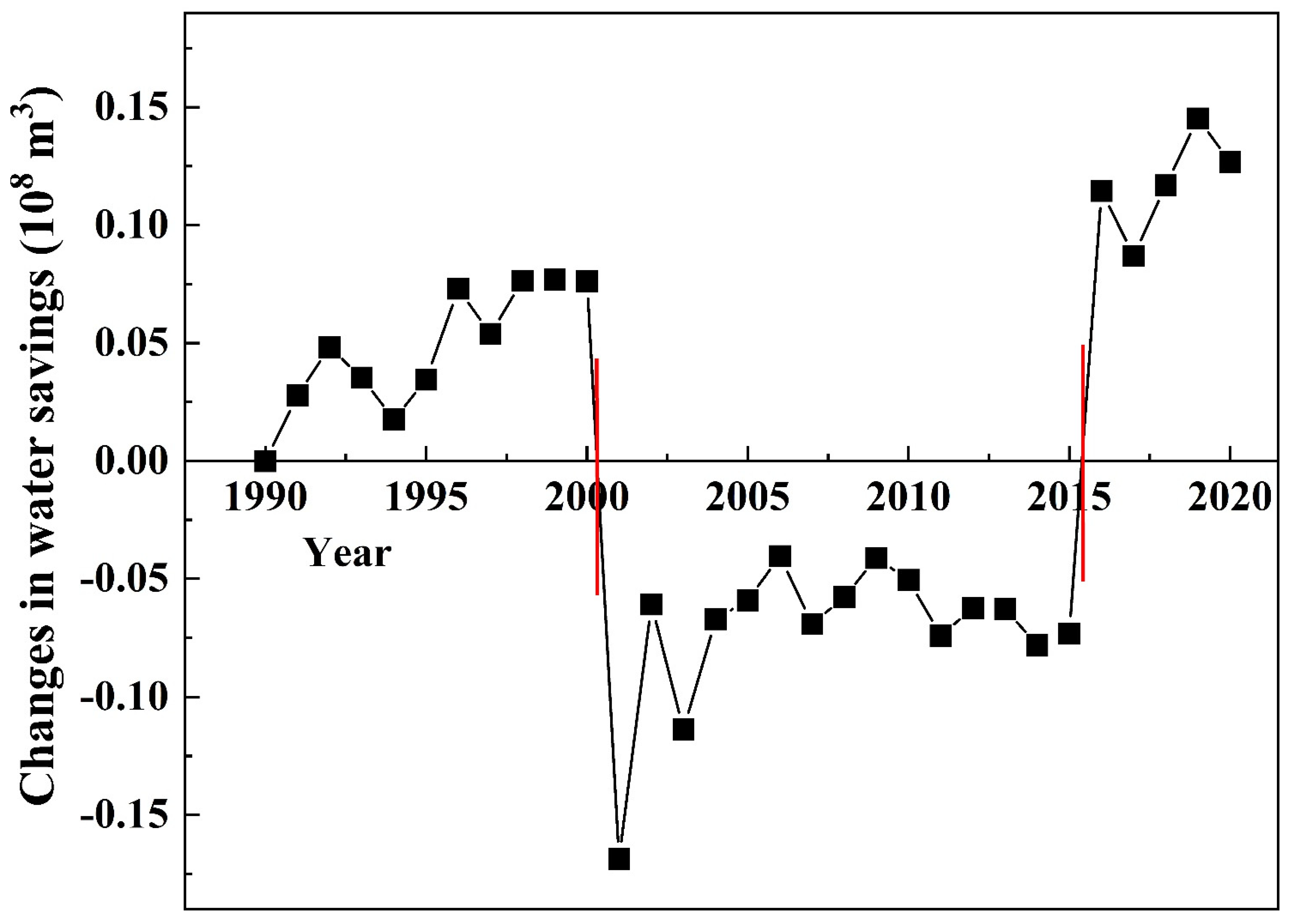
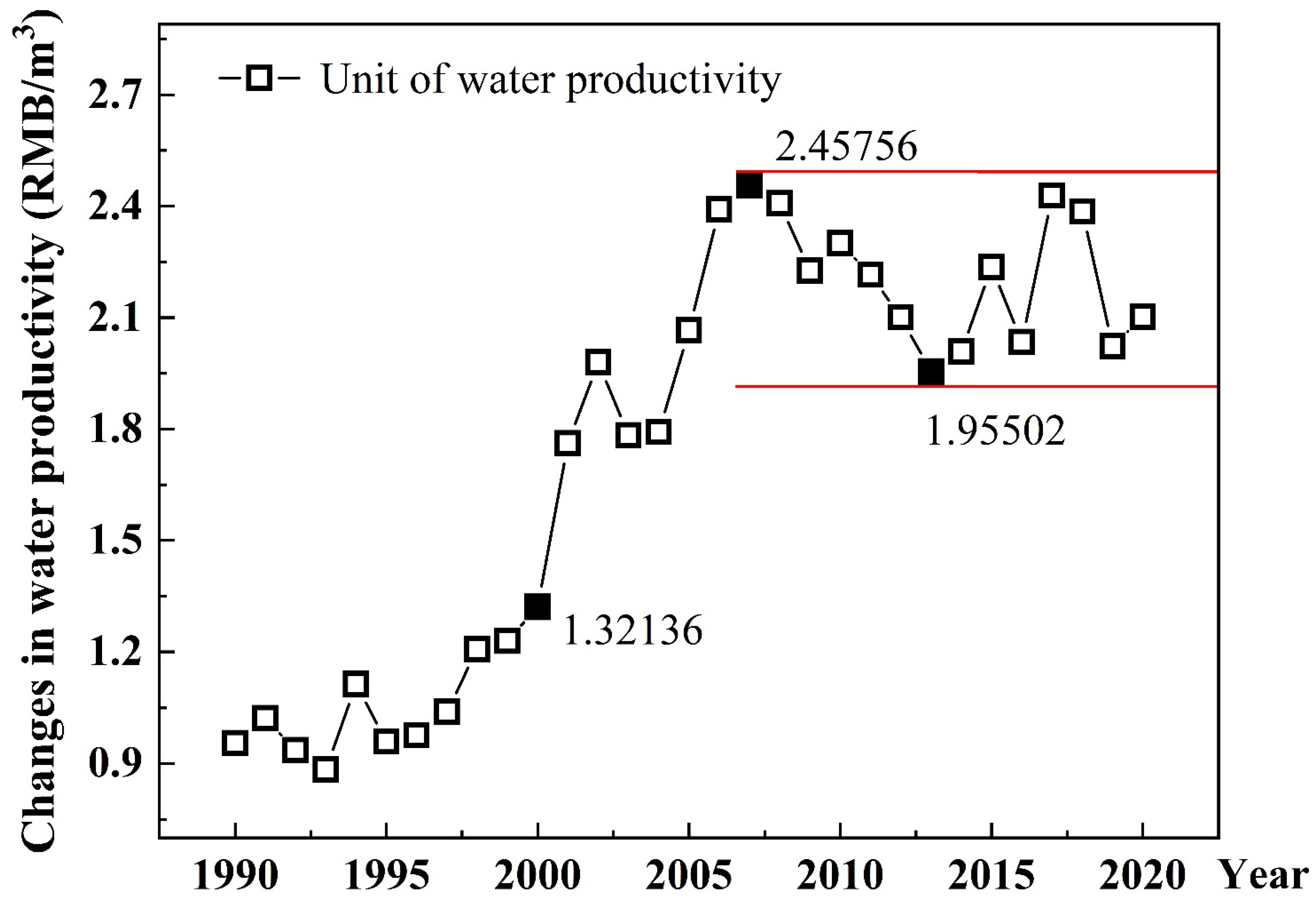
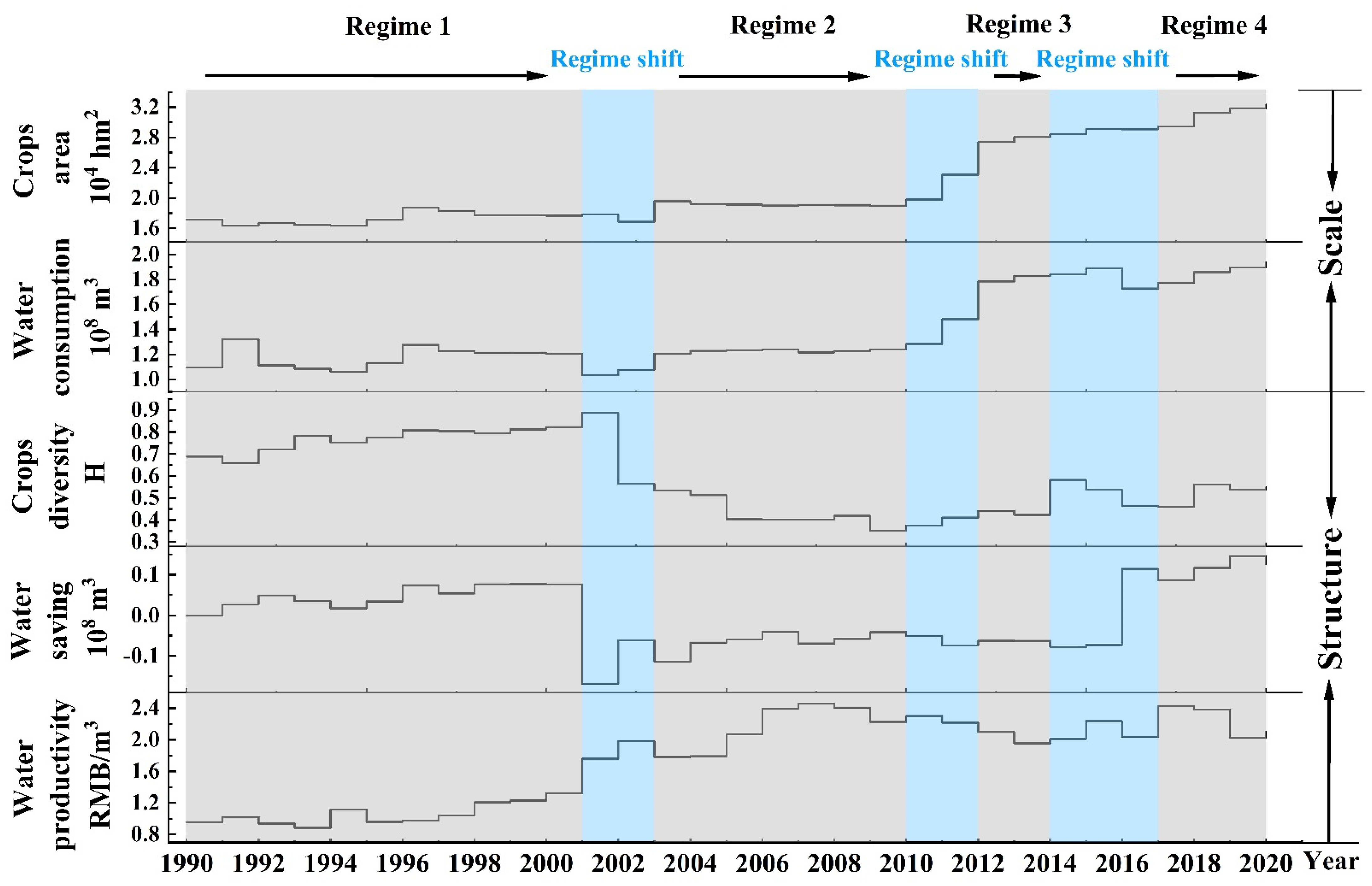
| Crops | Food Crops | Cash Crops | ||||||
|---|---|---|---|---|---|---|---|---|
| Wheat ① | Field Corn ① | Seed Corn ② | Vegetables ② | Oil Crops ② | Beet ① | Cotton ① | Stevia * | |
| ET (mm) | 435 | 656 | 671.2 | 674 | 377.3 | 677 | 675.5 | 589.5 |
Publisher’s Note: MDPI stays neutral with regard to jurisdictional claims in published maps and institutional affiliations. |
© 2022 by the authors. Licensee MDPI, Basel, Switzerland. This article is an open access article distributed under the terms and conditions of the Creative Commons Attribution (CC BY) license (https://creativecommons.org/licenses/by/4.0/).
Share and Cite
Zhang, J.; Zhang, W.; Li, D.; Chen, X.; Zhang, W. Regime Shifts in the Hexi Oases over the Past Three Decades: The Case of the Linze Oasis in the Middle Reaches of the Heihe River. Sustainability 2022, 14, 16309. https://doi.org/10.3390/su142316309
Zhang J, Zhang W, Li D, Chen X, Zhang W. Regime Shifts in the Hexi Oases over the Past Three Decades: The Case of the Linze Oasis in the Middle Reaches of the Heihe River. Sustainability. 2022; 14(23):16309. https://doi.org/10.3390/su142316309
Chicago/Turabian StyleZhang, Jinglin, Wei Zhang, Dongsheng Li, Xueliang Chen, and Wei Zhang. 2022. "Regime Shifts in the Hexi Oases over the Past Three Decades: The Case of the Linze Oasis in the Middle Reaches of the Heihe River" Sustainability 14, no. 23: 16309. https://doi.org/10.3390/su142316309
APA StyleZhang, J., Zhang, W., Li, D., Chen, X., & Zhang, W. (2022). Regime Shifts in the Hexi Oases over the Past Three Decades: The Case of the Linze Oasis in the Middle Reaches of the Heihe River. Sustainability, 14(23), 16309. https://doi.org/10.3390/su142316309






